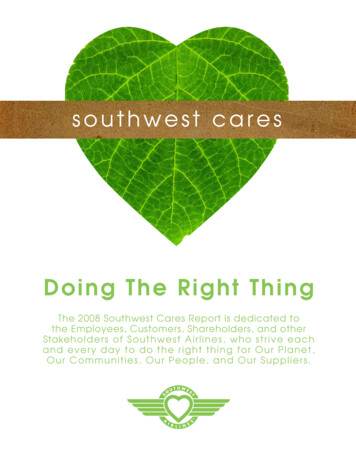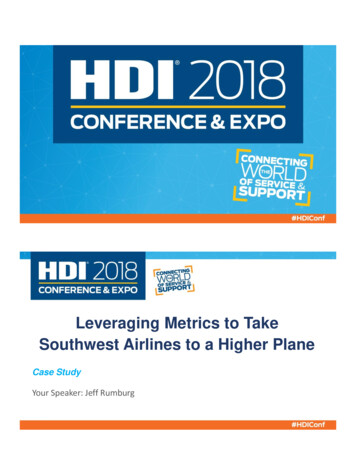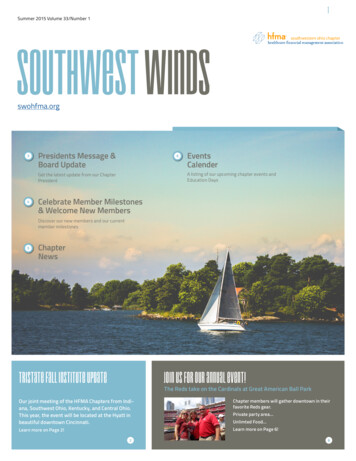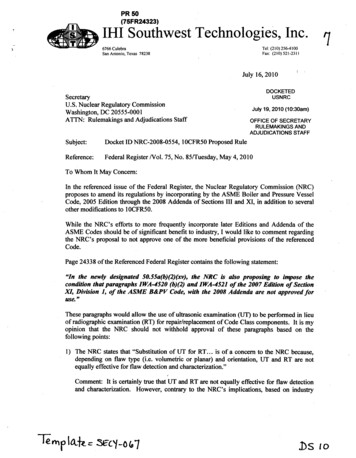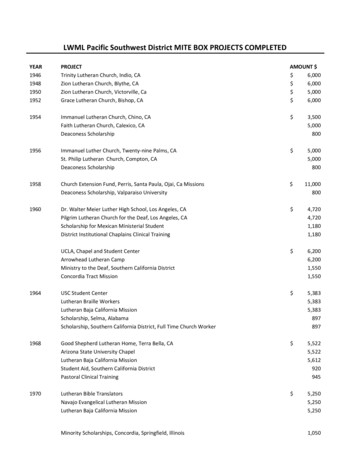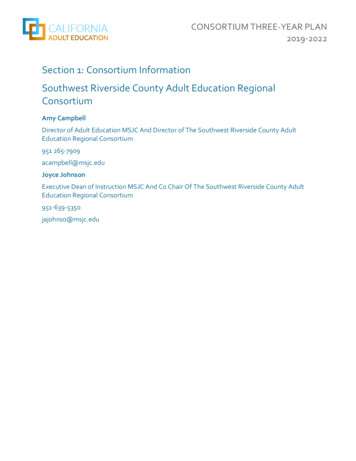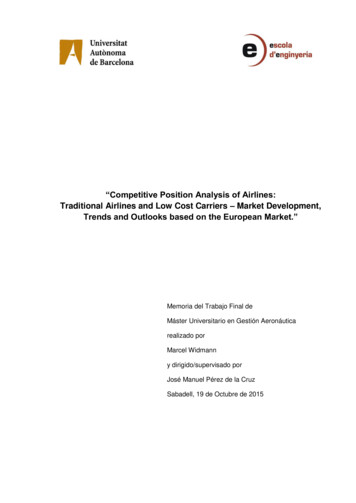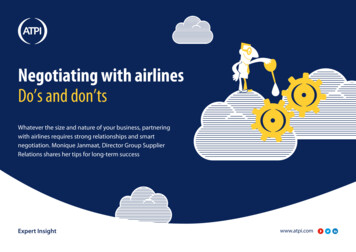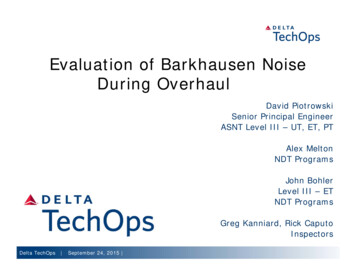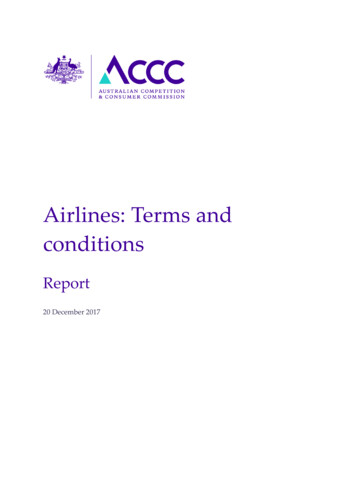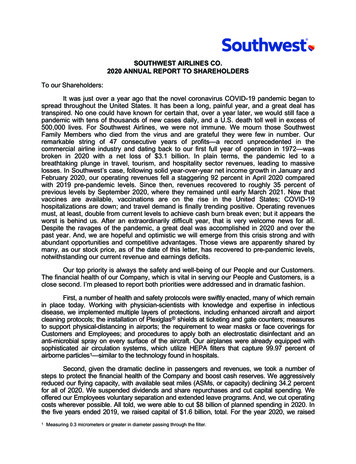
Transcription
SOUTHWEST AIRLINES CO.2020 ANNUAL REPORT TO SHAREHOLDERSTo our Shareholders:It was just over a year ago that the novel coronavirus COVID-19 pandemic began tospread throughout the United States. It has been a long, painful year, and a great deal hastranspired. No one could have known for certain that, over a year later, we would still face apandemic with tens of thousands of new cases daily, and a U.S. death toll well in excess of500,000 lives. For Southwest Airlines, we were not immune. We mourn those SouthwestFamily Members who died from the virus and are grateful they were few in number. Ourremarkable string of 47 consecutive years of profits—a record unprecedented in thecommercial airline industry and dating back to our first full year of operation in 1972—wasbroken in 2020 with a net loss of 3.1 billion. In plain terms, the pandemic led to abreathtaking plunge in travel, tourism, and hospitality sector revenues, leading to massivelosses. In Southwest’s case, following solid year-over-year net income growth in January andFebruary 2020, our operating revenues fell a staggering 92 percent in April 2020 comparedwith 2019 pre-pandemic levels. Since then, revenues recovered to roughly 35 percent ofprevious levels by September 2020, where they remained until early March 2021. Now thatvaccines are available, vaccinations are on the rise in the United States; COVID-19hospitalizations are down; and travel demand is finally trending positive. Operating revenuesmust, at least, double from current levels to achieve cash burn break even; but it appears theworst is behind us. After an extraordinarily difficult year, that is very welcome news for all.Despite the ravages of the pandemic, a great deal was accomplished in 2020 and over thepast year. And, we are hopeful and optimistic we will emerge from this crisis strong and withabundant opportunities and competitive advantages. Those views are apparently shared bymany, as our stock price, as of the date of this letter, has recovered to pre-pandemic levels,notwithstanding our current revenue and earnings deficits.Our top priority is always the safety and well-being of our People and our Customers.The financial health of our Company, which is vital in serving our People and Customers, is aclose second. I’m pleased to report both priorities were addressed and in dramatic fashion.First, a number of health and safety protocols were swiftly enacted, many of which remainin place today. Working with physician-scientists with knowledge and expertise in infectiousdisease, we implemented multiple layers of protections, including enhanced aircraft and airportcleaning protocols; the installation of Plexiglas shields at ticketing and gate counters; measuresto support physical-distancing in airports; the requirement to wear masks or face coverings forCustomers and Employees; and procedures to apply both an electrostatic disinfectant and ananti-microbial spray on every surface of the aircraft. Our airplanes were already equipped withsophisticated air circulation systems, which utilize HEPA filters that capture 99.97 percent ofairborne particles1—similar to the technology found in hospitals.Second, given the dramatic decline in passengers and revenues, we took a number ofsteps to protect the financial health of the Company and boost cash reserves. We aggressivelyreduced our flying capacity, with available seat miles (ASMs, or capacity) declining 34.2 percentfor all of 2020. We suspended dividends and share repurchases and cut capital spending. Weoffered our Employees voluntary separation and extended leave programs. And, we cut operatingcosts wherever possible. All told, we were able to cut 8 billion of planned spending in 2020. Inthe five years ended 2019, we raised capital of 1.6 billion, total. For the year 2020, we raised1Measuring 0.3 micrometers or greater in diameter passing through the filter.
18.9 billion, including 5.2 billion of re-financings. Importantly, we secured 3.4 billion in federalstimulus and loans through the Coronavirus Aid, Relief, and Economic Security Act (CARES Act).While this cash is vital to funding the inevitable operating losses incurred due to and during thispandemic, our immediate objective is to minimize cash burn so we emerge from this pandemic ina solid financial position to begin the recovery and repair process.For the year 2020, we incurred a net loss of 3.1 billion, or 5.44 loss per dilutedshare. These results included after-tax impacts: 1.5 billion in federal payroll support; 980 million in charges from voluntary Employee programs; and various other special items,including a gain from aircraft sale-leaseback transactions. Excluding these special items2, weincurred a net loss of 3.5 billion, or 6.22 loss per diluted share.We ended 2020 with a record level of liquidity, or 14.3 billion, including 11.1 billionin cash, 2.3 billion in short-term investments, and a fully-available, unsecured, revolvingcredit line of 1.0 billion. Importantly, this exceeded our 10.3 billion in long-term debt at theend of 2020. As a true testament to our strength and our preparedness, we have maintainedour investment grade credit ratings: Moody’s, Baa1; Standard & Poor’s, BBB; and Fitch,BBB . We entered 2020 with the strongest balance sheet in Southwest history, with adjusteddebt3-to-total invested capital of only 24 percent. Remarkably, we were able to absorb the2020 blow and end the year with adjusted balance sheet leverage of 56 percent.Total operating revenues were 9.0 billion, a 59.7 percent decrease compared with2019’s record 22.4 billion. The year-over-year plunge in passenger traffic accounts for thisdecline, with revenue passengers carried down 59.7 percent, also. ASMs were adjusted down34.2 percent, year-over-year, given the collapse in demand. And, load factor fell 31.1 pointsfrom a healthy 83.5 percent in 2019, to 52.4 percent in 2020. With very weak demand,average fares and passenger revenue yields (per revenue passenger mile, or RPMs) fell8.6 percent and 10.6 percent, respectively.Important, we did not eliminate any of the destinations we serve. Instead, we wereable to add six destinations in 2020 and have, to-date, announced 13 more for 2021. Westarted 2020 serving 101 destinations, having just launched service to the Hawaiian Islands in2019. We ended the year with 107 destinations, including 93 domestic, seven international,and seven temporarily suspended international markets due to COVID-19. I am very proudwe were able to serve all our domestic communities. I am grateful we had availableopportunities to add service and generate new Customers, trips, and revenues. Given asurplus of aircraft, Employees, and airport facilities, these proved to be positive cash flowalternatives to otherwise idle assets and personnel.Demand for commercial air travel generally falls into two broad categories: businessand consumer (or leisure). Typically, roughly 35 percent of our Passengers travel forbusiness, while the majority, or 65 percent, are traveling for personal reasons. The currentairline business depression is unique, in that it is driven more by pandemic-related healthconcerns rather than by economic or recessionary reasons.In past recessions, while leisure travel demand was reasonably sustained, businesstravel demand dropped sharply and was indifferent to fare incentives to stimulate marginaltravel. Historically, it has taken roughly five years, on average, for business travel to recoverto pre-recession levels. In 2020, with passenger counts down 60 percent, business travel,23See Note Regarding Use of Non-GAAP Financial Measures and related reconciliations included in the accompanyingForm 10-K for the fiscal year ended December 31, 2020, for additional information on special items.Adjusted debt is calculated as short-term and long-term debt including the net present value of aircraft rentals related tooperating leases.
predictably, dropped more—closer to 90 percent. It may take many years for business travelto recover to pre-pandemic levels, especially considering the swift, forced move to remoteoffice work enabled by online collaboration tools and video/audio conferencing technologies.Regardless of the rate of a rebound in business travel, we are better prepared with last year’slaunch of global distribution system (GDS) access through Amadeus and Travelport, and theplanned launch with Sabre later this year. Our GDS channel strategy complements existingSouthwest Business options with the goal of expanding service to corporate travelers throughtheir preferred booking channel, which we didn’t have access to prior to this initiative.We believe we are well-positioned for success. First, we have a low-fare brand that isbeloved by consumers. We do not charge hidden fees, including no charge for the first andsecond checked bags and no change fees4. We have a very generous frequent flyer programthat handsomely rewards travel on Southwest, as well as spending using the Southwestbranded Chase Visa credit card. Awards are redeemable for every open seat on everySouthwest flight. Our efficient, reliable, low-cost business model supports this low-fare brand.Our business model is famous for such attributes as point-to-point scheduling; a focus onnonstop itineraries; a single aircraft type that simplifies staffing, training, scheduling, operations,and maintenance and repairs; single class service; open seating; and direct distribution.Second, we have a strong presence across top markets, serving America’s largestcities, including an expanding array of attractive leisure destinations including Florida,Colorado, California, and Hawaii, to name only a few. In the last decade, we have added 14attractive, near-international destinations in Mexico, the Caribbean, and Central America.Since the pandemic began, our fleet of more than 700 aircraft became vastly underutilized.We began searching for new pools of Customers by introducing service to new leisuredestinations and seized opportunities to announce or open 17 new airports since March 1,2020. All told, these exciting new destinations will put roughly 40 idle aircraft and over 500Employees to work. We are well-prepared for a larger, more permanent mix of leisure travel,along with a predominantly domestic route network.Third, our People run a great operation and offer outstanding hospitality. I’llsummarize by saying our superb ontime performance5 was 86 percent in 2020, withCompany-record baggage handling accuracy, and an industry-best Customer SatisfactionRanking6 with the U.S. Department of Transportation—for the 27th time in the last 30 years.Our Customers remain huge fans, giving us a 2020 Net Promoter Score of 77. I am verygrateful for our Customers and their loyal support. I am enormously indebted to our Peoplewho make this happen every day, thousands of times. They are magnificent.Put these three themes together—it is a powerhouse combination made for themoment: low fares, best schedule, and best service. I believe we are perfectly situated with asuperior business model and for a leisure-led, low-fare environment. Add to that, we have theU.S. airline industry’s strongest balance sheet, and our competitive lead, in this regard, haswidened over the last year. All of this will be important, as we expect the next several yearswill be brutally competitive as the industry presses forward beyond survival on a long road ofrecovery and repair.Additionally, we have a longstanding history of being a responsible global citizen anddoing the right thing for our People, Performance, and Planet. Our commitments did not waiverduring the events of 2020. I am proud of how our Employees rose to the challenge in456Weight and size limits apply to bags, and fare differences may apply to itinerary changes.Ontime performance is measured by the percentage of flights that arrive within 15 minutes of scheduled arrival time asreported to the U.S. Department of Transportation (DOT).Source: Air Travel Consumer Reports. Rankings based on complaints filed with the DOT per 100,000 passengers.
support of our Customers, communities, and each other. We are excited to strengthen our work intwo key focus areas including diversity, equity, and inclusion (DEI), and environmentalsustainability. Regarding our DEI work, this past year has shone a spotlight on many importantissues surrounding racial injustice, discrimination, and a need in our world for what Southwest hasalways been known for—love. We have long been committed to diversity and inclusion and ourjourney began well before last summer’s increased national focus on racial injustice. While ourdiversity imperatives across the years laid a good foundation, 2020 helped us recognize we mustcommit to closely focusing in areas like diversity in our Senior Leadership and supplier diversity.We continue to look for opportunities to better reflect in our organization the diversedemographics of the communities we serve. Our Diversity, Equity, and Inclusion Department ispartnering with departments across the Company to make these commitments a reality, inaddition to their ongoing work to foster an inclusive work environment for our People.Our citizenship efforts also took an intentional focus on how we engage and interact withthe Planet. For years, we have evaluated and executed ways we can improve environmentalstewardship across our airline because we recognize we have a responsibility to the environment.Early last year, we launched a concentrated effort to find new ways to reduce our environmentalfootprint. This includes our intention to introduce sustainable aviation fuel into our supply chain,engage in carbon offsetting efforts where it makes sense, and improve our recycling efforts inflightand on the ground. We are working to establish strategic plans aimed at achieving carbonneutrality by 2050. While we are proud of our past citizenship accomplishments, we are ready todo more and know exciting things are ahead
planned launch with Sabre later this year. Our GDS channel strategy complements existing Southwest Business options with the goal of expanding service to corporate travelers through their preferred booking channel, which we didn’t have access to prior to this initiative. We believe we are well-positioned for success. First, we have a low-fare brand that is
